Comparative analysis of shopping carts
Purchases of each customer in the store only at first glance seem unique. Buyers produce the same behaviors based on needs, for example, buying milk and bread every other day, packs of cigarettes every evening, chocolates for tea, yogurt and a croissant for dinner, etc. And since, one way or another, the needs of people are the same, we can talk about typical consumer behavior under certain conditions.

Analysis of shopping carts involves the study of relationships and patterns in the behavior of customers trading network. The results of the analysis help form targeted marketing activities, create personalized offers and plan promotions to increase the average bill and profit.
')
We have already described the analysis of shopping carts here , and in this article, we will look at the comparison of typical baskets and the possibility of using the results in retail business processes. The ability to visualize and compare baskets with similar products helps the retailer to quickly identify patterns in consumer behavior and make the necessary decisions to optimize their operations.
We will conduct a comparative analysis using the BI Datawiz.io service.
The service helps to compare two typical baskets with different key products for the main indicators.
For example, how to determine what goes into shopping baskets on Friday evening with “Priluki” or “Marlboro” cigarettes is shown in the screenshot below.

Consider the examples of using the functional comparison of typical baskets in retail processes.
Example 1. To form a marketing strategy for product categories or brands by marketing network marketing specialists.
Compare two shopping baskets:
Having compared typical baskets, we see that Pryluky cigarettes are bought with instant coffee brands such as Nescafe, McCoffee, Jacobs and others. Also 2 times more often bread and bakery products get into typical baskets with “Priluki” cigarettes.
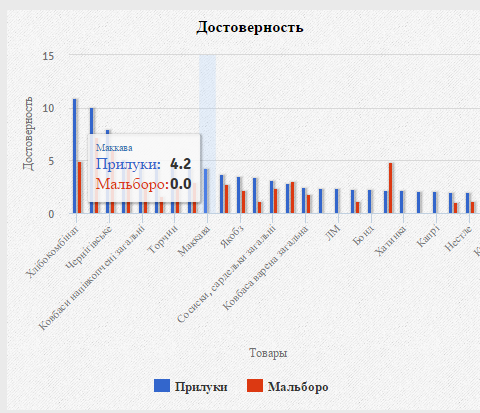
But with Marlboro cigarettes, smokers take Dirol and Orbit chewing gum, and Coca-Cola with Pepsi and mineral water also come out with frequent purchases of this brand of cigarettes.
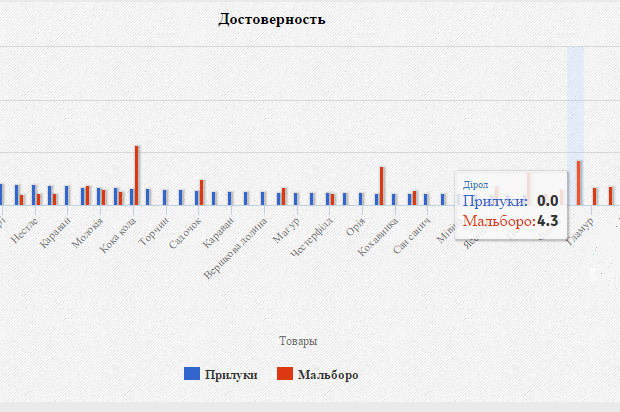
In this way, we get two different customer personalities.
Smoker of cigarettes "Pryluky" prefers hot instant drinks.
The Marlboro smoker is a Coke and keeps his breath fresh.
Therefore, the promotion, when buying a block of cigarettes as a gift to a client, is offered a glass of instant coffee, will be more successful for smokers Priluk. And for those who buy Marlboro, the cashier may offer to buy chewing gum.
Example 2. For placing goods on store shelves and efficient use of retail space.
We use information about typical baskets of a low price segment.
We will compare the baskets with the main products such as:
As can be seen, in the picture below, with “Pervak” vodka, “Slavutych” beer is bought in 29.2% of cases. This figure is 11 times higher than the probability of the same purchase with Uzhgorod cognac.

Cognac is 2 times more likely to take with Coke than vodka.
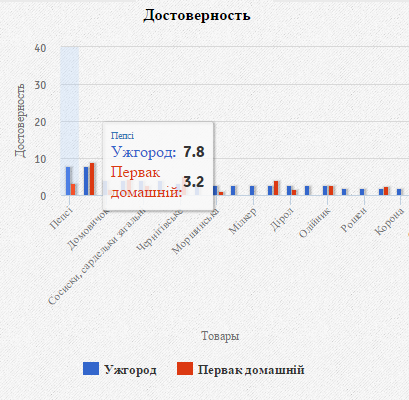
Inexpensive beer is placed near or opposite vodka, but sweet waters are next to cognacs and other alcoholic beverages, which are also washed down with Coca-Cola or Pepsi.
Example 3. For the formation of the layout of advertising media and promotional racks in the store.
For example, let's compare typical baskets with low alcohol drinks such as:
With a high probability of taking cider types of snacks, such as seeds, crackers, chips.
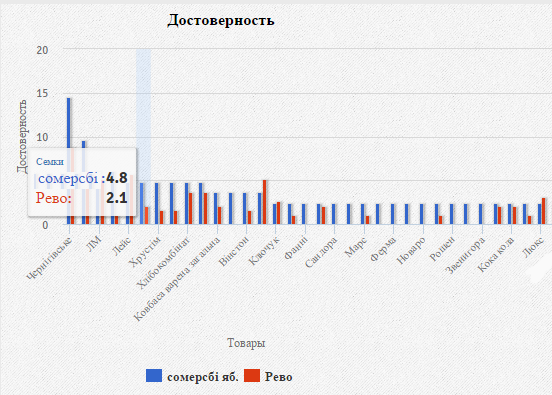
With Revo other low-alcohol drinks, such as Shake, and cigarettes.

Placement on a shelf with cider stock with snacks will increase the likelihood of a joint purchase.
But "Revo" can be left in a number of low-alcohol beverages. they will buy it with other drinks, or place it around the cashier for a quick purchase of it and cigarettes.
Example 4 When forming marketing activity and holding promotions - to increase the likelihood of buying goods together, choosing goods for winding up or decorating gift sets for the holidays.
Let us analyze the typical baskets with a price of up to 300 UAH, which includes:
Comparing the data on the graph below, we see that champagne is bought much more often with sweets, confectionery and chocolate.
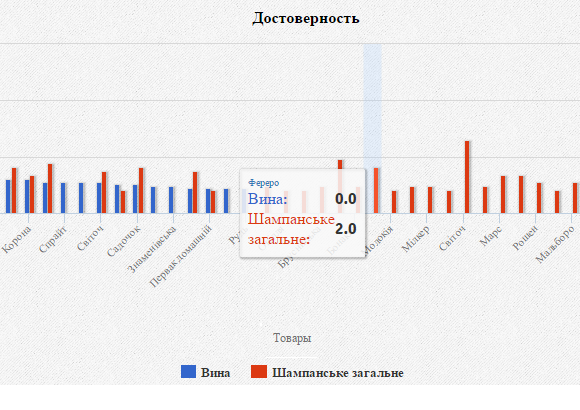
While wine is bought mainly with food for feasts - vodka, cheeses, mayonnaise, sausages, sauces, etc.

We can conclude that champagne should be used as a promotional item for the holidays. Reducing the price of it to increase the number of purchases or using in sets with boxes of chocolates on promotional racks. Such sets of visitors will buy as holiday gifts.
Example 5. When analyzing baskets by price segment .
Let's compare 2 typical baskets with vodka. Only in the first baskets there will be vodka “Zapadenka”, in the second - vodka “Finland”.
Do buyers in one basket put goods in the low and high price segment? The analysis shows that most goods are bought either with inexpensive alcohol or with elite.
In the picture below, we see that there are many products that buy Zapadenka with vodka, but for the whole of last year they have never bought Finland with vodka.
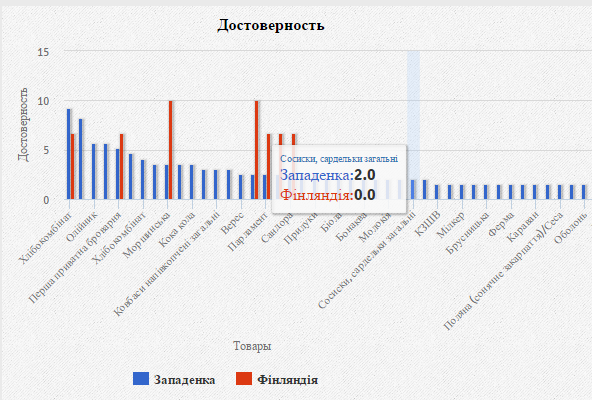
And vice versa. Finland is bought with Essentuki water, Martini alcohol, Davidoff cigarettes, elite alcohol. That is, the buyer allows himself 1 elite product, trying to pick up others in the same price segment.

There is not such a big list of brands that are bought at the same time with expensive and cheap vodka. These are such brands as: Mirgorodskaya and Morshinskaya mineral water, Pepsi, Sandora juices, Milk milk, Roshen sweets, Winston cigarettes and bread. In all other respects, baskets differ.
That is, when conducting promotions and positioning alcoholic beverages, it is worth considering the price segment to which it relates, and in addition to it, use goods of the same segment.
The described methods are only a few possibilities of using information about the goods that the buyer put in his basket. But they already give the retailer the opportunity:
The use of information on shopping carts with a link to loyalty programs and customer segmentation works well, this provides additional opportunities for analysis and an integrated approach to studying customers in grocery retail. We will talk about this in more detail in the following publications.
The BI Datawiz.io service allows the retailer to compare shopping baskets, identify patterns in consumer behavior and develop strategies to promote various products to generate additional profits.

Analysis of shopping carts involves the study of relationships and patterns in the behavior of customers trading network. The results of the analysis help form targeted marketing activities, create personalized offers and plan promotions to increase the average bill and profit.
')
We have already described the analysis of shopping carts here , and in this article, we will look at the comparison of typical baskets and the possibility of using the results in retail business processes. The ability to visualize and compare baskets with similar products helps the retailer to quickly identify patterns in consumer behavior and make the necessary decisions to optimize their operations.
We will conduct a comparative analysis using the BI Datawiz.io service.
The service helps to compare two typical baskets with different key products for the main indicators.
For example, how to determine what goes into shopping baskets on Friday evening with “Priluki” or “Marlboro” cigarettes is shown in the screenshot below.

Consider the examples of using the functional comparison of typical baskets in retail processes.
Example 1. To form a marketing strategy for product categories or brands by marketing network marketing specialists.
Compare two shopping baskets:
- with Priluki cigarettes;
- with Marlboro cigarettes.
Having compared typical baskets, we see that Pryluky cigarettes are bought with instant coffee brands such as Nescafe, McCoffee, Jacobs and others. Also 2 times more often bread and bakery products get into typical baskets with “Priluki” cigarettes.

But with Marlboro cigarettes, smokers take Dirol and Orbit chewing gum, and Coca-Cola with Pepsi and mineral water also come out with frequent purchases of this brand of cigarettes.

In this way, we get two different customer personalities.
Smoker of cigarettes "Pryluky" prefers hot instant drinks.
The Marlboro smoker is a Coke and keeps his breath fresh.
Therefore, the promotion, when buying a block of cigarettes as a gift to a client, is offered a glass of instant coffee, will be more successful for smokers Priluk. And for those who buy Marlboro, the cashier may offer to buy chewing gum.
Example 2. For placing goods on store shelves and efficient use of retail space.
We use information about typical baskets of a low price segment.
We will compare the baskets with the main products such as:
- vodka “Pervak”;
- cognac "Uzhgorod".
As can be seen, in the picture below, with “Pervak” vodka, “Slavutych” beer is bought in 29.2% of cases. This figure is 11 times higher than the probability of the same purchase with Uzhgorod cognac.

Cognac is 2 times more likely to take with Coke than vodka.

Inexpensive beer is placed near or opposite vodka, but sweet waters are next to cognacs and other alcoholic beverages, which are also washed down with Coca-Cola or Pepsi.
Example 3. For the formation of the layout of advertising media and promotional racks in the store.
For example, let's compare typical baskets with low alcohol drinks such as:
- cider "Somersby";
- drink “Revo”.
With a high probability of taking cider types of snacks, such as seeds, crackers, chips.

With Revo other low-alcohol drinks, such as Shake, and cigarettes.

Placement on a shelf with cider stock with snacks will increase the likelihood of a joint purchase.
But "Revo" can be left in a number of low-alcohol beverages. they will buy it with other drinks, or place it around the cashier for a quick purchase of it and cigarettes.
Example 4 When forming marketing activity and holding promotions - to increase the likelihood of buying goods together, choosing goods for winding up or decorating gift sets for the holidays.
Let us analyze the typical baskets with a price of up to 300 UAH, which includes:
- domestic wines;
- champagne.
Comparing the data on the graph below, we see that champagne is bought much more often with sweets, confectionery and chocolate.

While wine is bought mainly with food for feasts - vodka, cheeses, mayonnaise, sausages, sauces, etc.

We can conclude that champagne should be used as a promotional item for the holidays. Reducing the price of it to increase the number of purchases or using in sets with boxes of chocolates on promotional racks. Such sets of visitors will buy as holiday gifts.
Example 5. When analyzing baskets by price segment .
Let's compare 2 typical baskets with vodka. Only in the first baskets there will be vodka “Zapadenka”, in the second - vodka “Finland”.
Do buyers in one basket put goods in the low and high price segment? The analysis shows that most goods are bought either with inexpensive alcohol or with elite.
In the picture below, we see that there are many products that buy Zapadenka with vodka, but for the whole of last year they have never bought Finland with vodka.

And vice versa. Finland is bought with Essentuki water, Martini alcohol, Davidoff cigarettes, elite alcohol. That is, the buyer allows himself 1 elite product, trying to pick up others in the same price segment.

There is not such a big list of brands that are bought at the same time with expensive and cheap vodka. These are such brands as: Mirgorodskaya and Morshinskaya mineral water, Pepsi, Sandora juices, Milk milk, Roshen sweets, Winston cigarettes and bread. In all other respects, baskets differ.
That is, when conducting promotions and positioning alcoholic beverages, it is worth considering the price segment to which it relates, and in addition to it, use goods of the same segment.
The described methods are only a few possibilities of using information about the goods that the buyer put in his basket. But they already give the retailer the opportunity:
- form the right product promotion strategy depending on customers' purchasing preferences;
- develop effective approaches to the placement of goods on the shelves;
- place promotional racks and superstructures on the shelves in the right places, near those goods that are more likely to buy together;
- determine the desired pricing policy, manage stocks, properly reduce and increase the prices of related products.
The use of information on shopping carts with a link to loyalty programs and customer segmentation works well, this provides additional opportunities for analysis and an integrated approach to studying customers in grocery retail. We will talk about this in more detail in the following publications.
The BI Datawiz.io service allows the retailer to compare shopping baskets, identify patterns in consumer behavior and develop strategies to promote various products to generate additional profits.
Source: https://habr.com/ru/post/271757/
All Articles